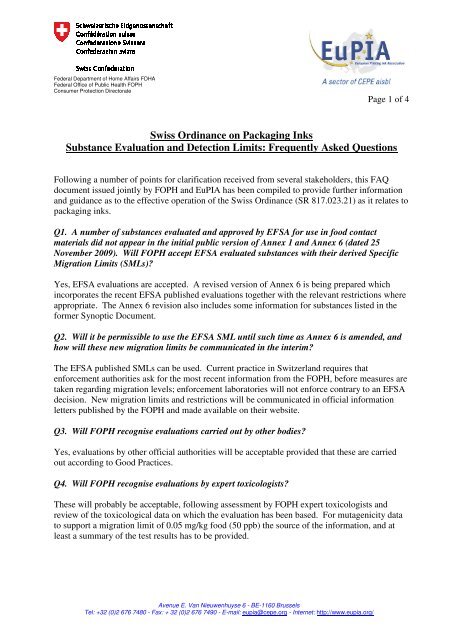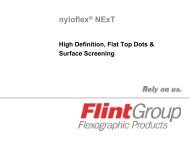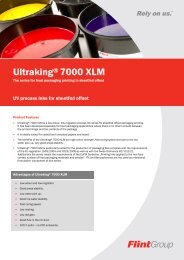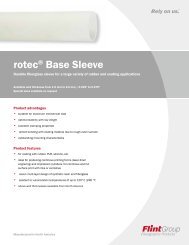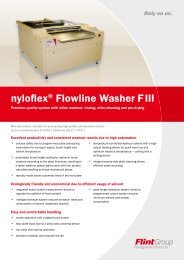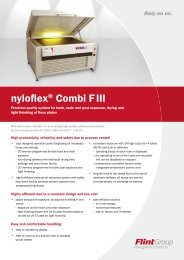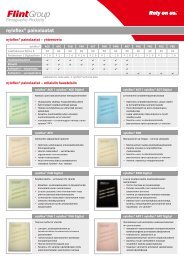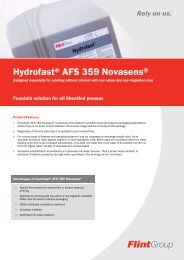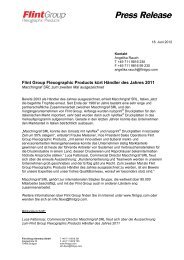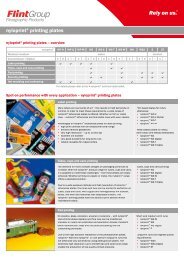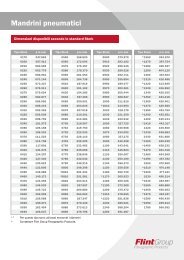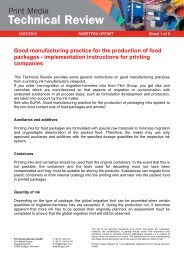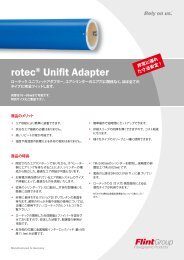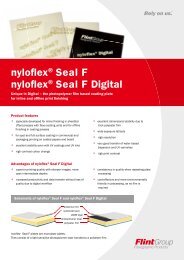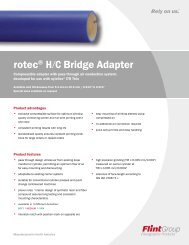100913 Swiss Ordinance on Packaging Inks faq Substance - Eudata
100913 Swiss Ordinance on Packaging Inks faq Substance - Eudata
100913 Swiss Ordinance on Packaging Inks faq Substance - Eudata
Create successful ePaper yourself
Turn your PDF publications into a flip-book with our unique Google optimized e-Paper software.
Federal Department of Home Affairs FDHA<br />
Federal Office of Public Health FOPH<br />
C<strong>on</strong>sumer Protecti<strong>on</strong> Directorate<br />
Avenue E. Van Nieuwenhuyse 6 - BE-1160 Brussels<br />
Tel: +32 (0)2 676 7480 - Fax: + 32 (0)2 676 7490 - E-mail: eupia@cepe.org - Internet: http://www.eupia.org/<br />
Page 1 of 4<br />
<str<strong>on</strong>g>Swiss</str<strong>on</strong>g> <str<strong>on</strong>g>Ordinance</str<strong>on</strong>g> <strong>on</strong> <strong>Packaging</strong> <strong>Inks</strong><br />
<strong>Substance</strong> Evaluati<strong>on</strong> and Detecti<strong>on</strong> Limits: Frequently Asked Questi<strong>on</strong>s<br />
Following a number of points for clarificati<strong>on</strong> received from several stakeholders, this FAQ<br />
document issued jointly by FOPH and EuPIA has been compiled to provide further informati<strong>on</strong><br />
and guidance as to the effective operati<strong>on</strong> of the <str<strong>on</strong>g>Swiss</str<strong>on</strong>g> <str<strong>on</strong>g>Ordinance</str<strong>on</strong>g> (SR 817.023.21) as it relates to<br />
packaging inks.<br />
Q1. A number of substances evaluated and approved by EFSA for use in food c<strong>on</strong>tact<br />
materials did not appear in the initial public versi<strong>on</strong> of Annex 1 and Annex 6 (dated 25<br />
November 2009). Will FOPH accept EFSA evaluated substances with their derived Specific<br />
Migrati<strong>on</strong> Limits (SMLs)?<br />
Yes, EFSA evaluati<strong>on</strong>s are accepted. A revised versi<strong>on</strong> of Annex 6 is being prepared which<br />
incorporates the recent EFSA published evaluati<strong>on</strong>s together with the relevant restricti<strong>on</strong>s where<br />
appropriate. The Annex 6 revisi<strong>on</strong> also includes some informati<strong>on</strong> for substances listed in the<br />
former Synoptic Document.<br />
Q2. Will it be permissible to use the EFSA SML until such time as Annex 6 is amended, and<br />
how will these new migrati<strong>on</strong> limits be communicated in the interim?<br />
The EFSA published SMLs can be used. Current practice in Switzerland requires that<br />
enforcement authorities ask for the most recent informati<strong>on</strong> from the FOPH, before measures are<br />
taken regarding migrati<strong>on</strong> levels; enforcement laboratories will not enforce c<strong>on</strong>trary to an EFSA<br />
decisi<strong>on</strong>. New migrati<strong>on</strong> limits and restricti<strong>on</strong>s will be communicated in official informati<strong>on</strong><br />
letters published by the FOPH and made available <strong>on</strong> their website.<br />
Q3. Will FOPH recognise evaluati<strong>on</strong>s carried out by other bodies?<br />
Yes, evaluati<strong>on</strong>s by other official authorities will be acceptable provided that these are carried<br />
out according to Good Practices.<br />
Q4. Will FOPH recognise evaluati<strong>on</strong>s by expert toxicologists?<br />
These will probably be acceptable, following assessment by FOPH expert toxicologists and<br />
review of the toxicological data <strong>on</strong> which the evaluati<strong>on</strong> has been based. For mutagenicity data<br />
to support a migrati<strong>on</strong> limit of 0.05 mg/kg food (50 ppb) the source of the informati<strong>on</strong>, and at<br />
least a summary of the test results has to be provided.
Federal Department of Home Affairs FDHA<br />
Federal Office of Public Health FOPH<br />
C<strong>on</strong>sumer Protecti<strong>on</strong> Directorate<br />
Avenue E. Van Nieuwenhuyse 6 - BE-1160 Brussels<br />
Tel: +32 (0)2 676 7480 - Fax: + 32 (0)2 676 7490 - E-mail: eupia@cepe.org - Internet: http://www.eupia.org/<br />
Page 2 of 4<br />
Q5. Will FOPH accept the use of additi<strong>on</strong>al uncertainty factors, as described in REACH<br />
technical guidance Chapter R8, to allow for extrapolati<strong>on</strong>/read across of toxicity data from<br />
different exposure routes and study durati<strong>on</strong>s?<br />
Under certain c<strong>on</strong>diti<strong>on</strong>s, extrapolati<strong>on</strong> from different exposure routes or times is possible. For<br />
instance, if <strong>on</strong>ly a 28-day study is available instead of a 90-day study, extrapolati<strong>on</strong> from<br />
subacute to chr<strong>on</strong>ic exposure is possible using an additi<strong>on</strong>al assessment factor. This factor<br />
depends <strong>on</strong> the quality of the study and is chosen <strong>on</strong> a case-by-case basis.<br />
Q6. Can a missing in-vitro genotoxicity test be compensated for by two favourable in-vitro<br />
tests and an absence of structure alerts, when supported by additi<strong>on</strong>al repeat dose data and<br />
read across from similar substances?<br />
Principally, three in-vitro genotoxicity tests are required for the evaluati<strong>on</strong> and approval of<br />
substances in food c<strong>on</strong>tact materials. Under certain c<strong>on</strong>diti<strong>on</strong>s, <strong>on</strong>ly 2 in-vitro mutagenicity<br />
studies will be available, e.g. for new chemical substances notified under the EU ELINCS<br />
system up to 100 T/a. In this situati<strong>on</strong>, both in-vitro genotoxicity tests (<strong>on</strong>e mutati<strong>on</strong> test, <strong>on</strong>e<br />
clastogenicity test) have to be negative and the absence of structural alerts for potential<br />
genotoxicity has to be shown to support a migrati<strong>on</strong> limit of 0.05 mg/kg. Instead of absence of<br />
structural alerts for potential genotoxicity, it can be shown that genotoxicity is not probable by<br />
read-across from structurally-related compounds.<br />
Additi<strong>on</strong>al repeat dose data will not help to clarify the genotoxicity profile of a substance. In<br />
case of a positive in-vitro genotoxicity test, a corresp<strong>on</strong>ding in-vivo genotoxicity study will be<br />
required to disprove this effect.<br />
Q7. Will FOPH accept the use of data, study summaries and evaluati<strong>on</strong>s from reputable<br />
sources such as OECD HPV, SIDS/SIAR/SIAM, REACH-IT, IUCLID, etc?<br />
Data evaluated under the HPV programme by official competent authorities should be<br />
acceptable. Data that has not been evaluated and held in repositories will require assessment<br />
As a matter of principle, the higher the expected migrati<strong>on</strong> limit, the more demanding are the<br />
requirements <strong>on</strong> the data. Reported toxicological end-points or study summaries may not<br />
provide sufficient informati<strong>on</strong> to derive a robust migrati<strong>on</strong> limit, without recourse to the full<br />
study.<br />
Q8. How l<strong>on</strong>g is an evaluati<strong>on</strong> expected to take?<br />
If all the data is available, and there are no complicati<strong>on</strong>s, an evaluati<strong>on</strong> should take<br />
approximately <strong>on</strong>e m<strong>on</strong>th. However, this process can take much l<strong>on</strong>ger if a dialogue with the<br />
notifier is required, or if additi<strong>on</strong>al data has to be generated. The evaluati<strong>on</strong> is d<strong>on</strong>e by two<br />
FOPH toxicologists, without a further committee procedure.
Federal Department of Home Affairs FDHA<br />
Federal Office of Public Health FOPH<br />
C<strong>on</strong>sumer Protecti<strong>on</strong> Directorate<br />
Q9. How many substance dossiers have been received and evaluated?<br />
Avenue E. Van Nieuwenhuyse 6 - BE-1160 Brussels<br />
Tel: +32 (0)2 676 7480 - Fax: + 32 (0)2 676 7490 - E-mail: eupia@cepe.org - Internet: http://www.eupia.org/<br />
Page 3 of 4<br />
Six new substances have been notified since March 2010, and <strong>on</strong>e substance has been evaluated.<br />
Q10. When can a newly notified substance be placed <strong>on</strong> the market?<br />
A substance may be used as so<strong>on</strong> as the notifier has received c<strong>on</strong>firmati<strong>on</strong> of receipt of the<br />
dossier by the FOPH.<br />
Q11. Once the newly notified substance is placed <strong>on</strong> the market, what migrati<strong>on</strong> limits or<br />
restricti<strong>on</strong>s apply in the interim period before the evaluati<strong>on</strong> and decisi<strong>on</strong> from FOPH?<br />
The limit that is proposed in the dossier is accepted ad interim.<br />
Q12. Similarly, what limits should apply to the substances listed in Informati<strong>on</strong> Note No 153?<br />
No limits are specified, but it will depend <strong>on</strong> the limit proposed in the justificati<strong>on</strong> for reevaluati<strong>on</strong>:<br />
the decisi<strong>on</strong> will have to be taken case by case. Once the re-evaluati<strong>on</strong> of these<br />
substances is complete, the migrati<strong>on</strong> limits will be published and made available to the<br />
enforcing laboratories.<br />
Q13. Art. 26g of the Regulati<strong>on</strong> requires that packaging inks may <strong>on</strong>ly be manufactured from<br />
substances listed in Annex 1 and in Annex 6. Does this require that substances are listed in<br />
both Annex 1 and Annex 6?<br />
This is an unfortunate mis-interpretati<strong>on</strong> arising from translati<strong>on</strong>. Advice by the legal services<br />
c<strong>on</strong>firms that the interpretati<strong>on</strong> “listed in annex 1 or in annex 6” is correct.<br />
Q14. How are substances not listed in Annex 1 or Annex 6, such as newly notified substances<br />
to be treated? Should they be regarded as though they are listed in Annex 1 or 6 from the<br />
point of notificati<strong>on</strong>, even though they may not appear in the published versi<strong>on</strong> until the next<br />
revisi<strong>on</strong>/publicati<strong>on</strong> date?<br />
FOPH will adopt a pragmatic approach. See answers to Questi<strong>on</strong>s 2, 10 and 11.<br />
Q15. Does this also apply to those substances identified in Informati<strong>on</strong> Note No 153 as Annex<br />
6 List of missing substances?<br />
Yes, see answer to Questi<strong>on</strong> 14.<br />
Q16. What migrati<strong>on</strong> limits should be observed for the substances identified in Informati<strong>on</strong><br />
Note No 153 as List of substances under evaluati<strong>on</strong> for a transfer to Part A ?<br />
See answer to Questi<strong>on</strong> 12.
Federal Department of Home Affairs FDHA<br />
Federal Office of Public Health FOPH<br />
C<strong>on</strong>sumer Protecti<strong>on</strong> Directorate<br />
Q17. How are substances that are also used as food additives to be treated?<br />
Avenue E. Van Nieuwenhuyse 6 - BE-1160 Brussels<br />
Tel: +32 (0)2 676 7480 - Fax: + 32 (0)2 676 7490 - E-mail: eupia@cepe.org - Internet: http://www.eupia.org/<br />
Page 4 of 4<br />
So-called dual use substances must be listed in Annex 6, as – different from the EU regulati<strong>on</strong>s –<br />
they are not covered by the <str<strong>on</strong>g>Ordinance</str<strong>on</strong>g>.<br />
Q18. Is the limit of detecti<strong>on</strong> using a validated method c<strong>on</strong>sidered to be 0.01 mg/kg food?<br />
For practical reas<strong>on</strong>s, a detecti<strong>on</strong> limit of 0.01 mg/kg food is accepted, i.e. below 10 ppb is<br />
c<strong>on</strong>sidered not detectable. FOPH will observe the same interpretati<strong>on</strong>s as for the EU Plastics<br />
Directive.<br />
Q19. Is it required to always have an analytical method capable of detecting down to 0.01<br />
mg/kg food? What happens if it is not possible to detect to such a low limit despite the best<br />
methods?<br />
There is no general answer to the questi<strong>on</strong>. Therefore, the appropriateness of the analytical<br />
method will be assessed <strong>on</strong> a case-by-case basis.<br />
This FAQ document is based <strong>on</strong> current understanding and interpretati<strong>on</strong>, and will be updated to<br />
reflect changes or significant new questi<strong>on</strong>s requiring additi<strong>on</strong>al clarificati<strong>on</strong>.<br />
FOPH/EuPIA<br />
13 th September 2010


